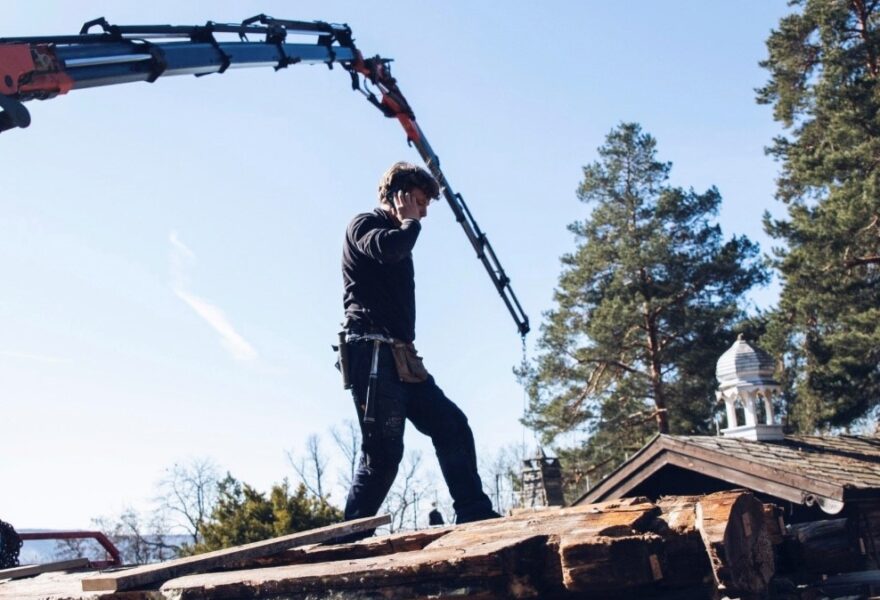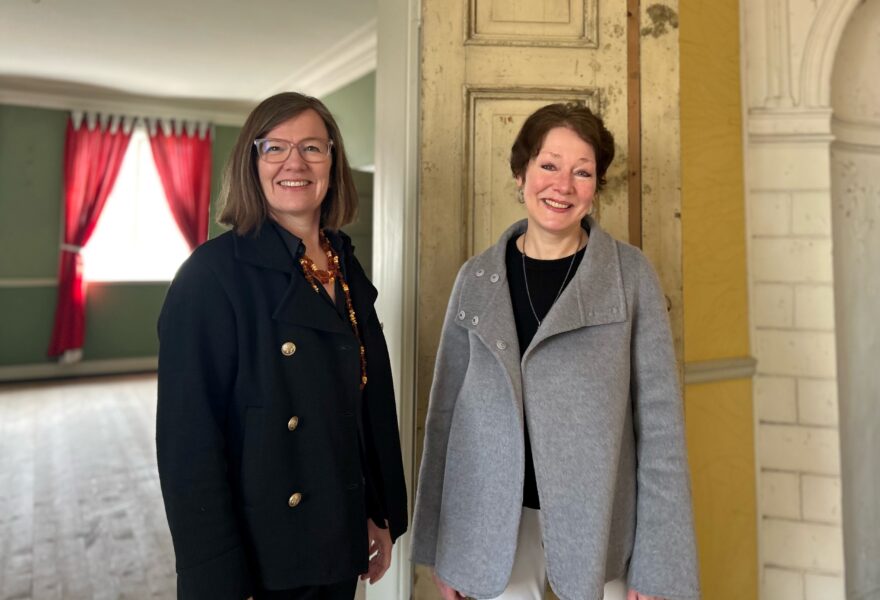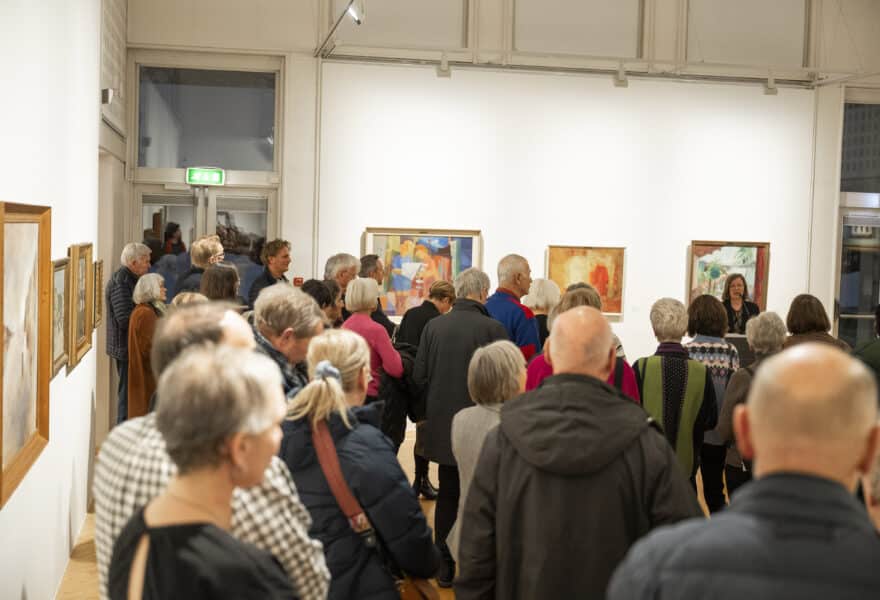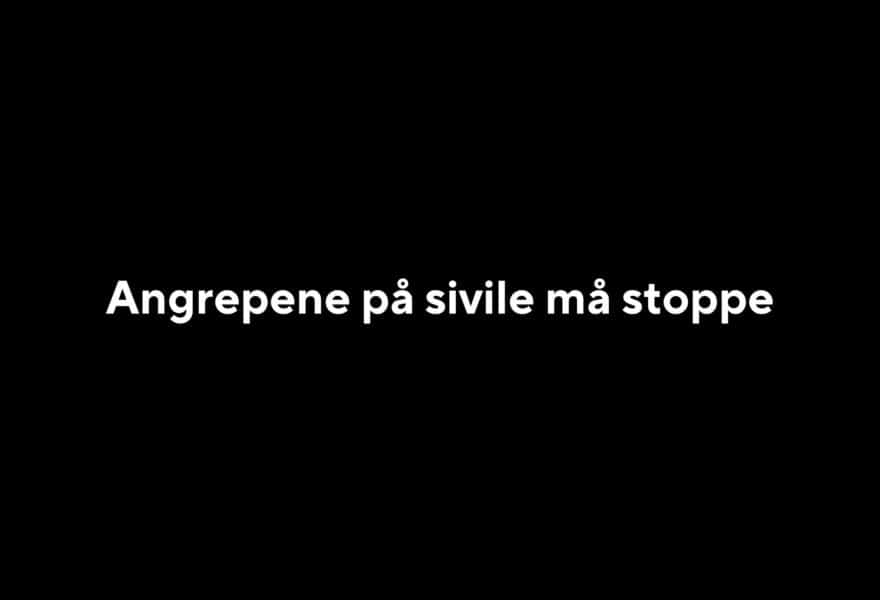
The pleasure garden at Marienlyst
The Marienlyst project – revitalization, anchoring and inclusion
Revitalization of Marienlyst
There are many choices to be made to make the Marienlyst amusement park central to the further development of local identity in Drammen. We will move from academic issues to making it accessible to everyone. Therefore, we must include the public in the entire process.
Course
29 April, 6 May and 13 May: Course in painting and exterior cladding
Lecture with theme from Marienlyst in 2024:
February 14: Building historian Jo Sellæg: "The mystery of Marienlyst and the battle for pleasure garden hegemony"
March 20: Conservator at the Norwegian Folk Museum, Geir Thomas Risåsen: "Historical Easter traditions"
May 25: Garden walk in the historic garden by the museum gardener at the Norwegian Folk Museum, Jan Høvo
- program for autumn 2024 is coming-
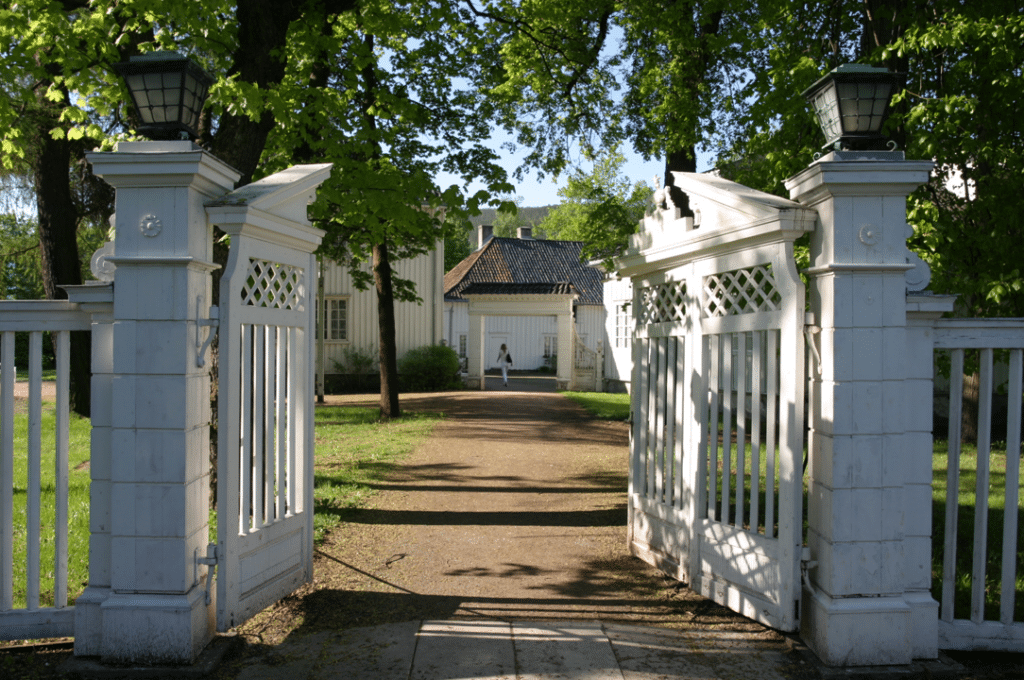
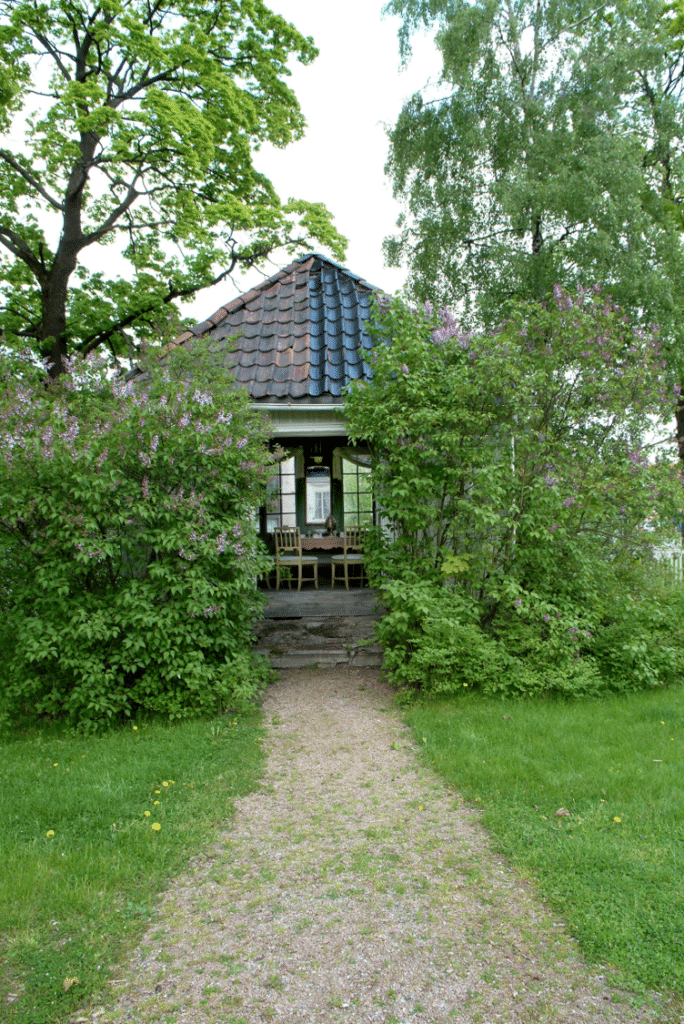
The Marienlyst project
After having been a display site for Drammen Museum's collections from 1911 to 1930 and then a manor house museum with style-historical exhibitions, the pleasure farm Marienlyst will undergo an extensive restoration and revitalization process. This applies to both the building mass itself and the interiors. The facility has been closed and locked for 20 years and now we will rethink how we can update the dissemination of this project to make Marienlyst relevant to different audience groups.
The starting point is to anchor the project in the facility's history and the city's history in order to obtain the important basis for the work with the restoration project and the dissemination of this going forward.
The story of Marienlyst reflects both the history of Drammen, the history of the region and the history of Norway. Not least, we can draw in the connection to the great outdoors. Sigurd Grieg writes the following in the article "Senmiddelalderske funn fra Drammenselven" printed in the yearbook 1928-1933: "Drammen's old trade connections must be sought in the cities of northern Germany and the Netherlands." The important export of timber to Germany, the Netherlands and England, and the import of goods from all over Europe took place from Drammen. The harbor was the heart of the city. As it can also be said to be today.
Marienlyst as a meeting place - then and now
Now our vision is that the planned opening of Marienlyst will lead to a deeper understanding of the facility and thus of the city's history. Marienlyst will be open to the public at selected times throughout the restoration process to convey the importance of the restoration work and not least how unique this pleasure garden is. We will draw the long historical lines and at the same time plan how we will use the pleasure garden for exhibitions and events.
The lecture series on various topics that can be linked to Marienlyst is also an important meeting place. All themes must be linked directly to the Marienlyst project. Why is it so important to take care of Marienlyst? What does it mean for local history and Drammen's identity? Einar Sørensen hosted the premiere with a packed house. We will continue this lecture series in the spring with invited professionals to convey topics that are relevant to the project. Only until February 2024 is Jo Sellæg. In March, conservator Geir Thomas Risåsen from the Norwegian Folk Museum, who is an expert on historical Easter traditions, will come and in April, Bård Frydenlund, director of Eidsvoll 1814, will come, who will talk about Marienlyst and the Manor Network.
It's at Marienlyst that it's happening!
New learning arena for craftsmen in Buskerud
A large grant secures the Marienlyst project: Drammen's Museum has been awarded NOK 4.2 million to establish the Marienlyst pleasure farm as a learning arena for the transfer of knowledge of traditional crafts over the next two years.
Løken Bygg
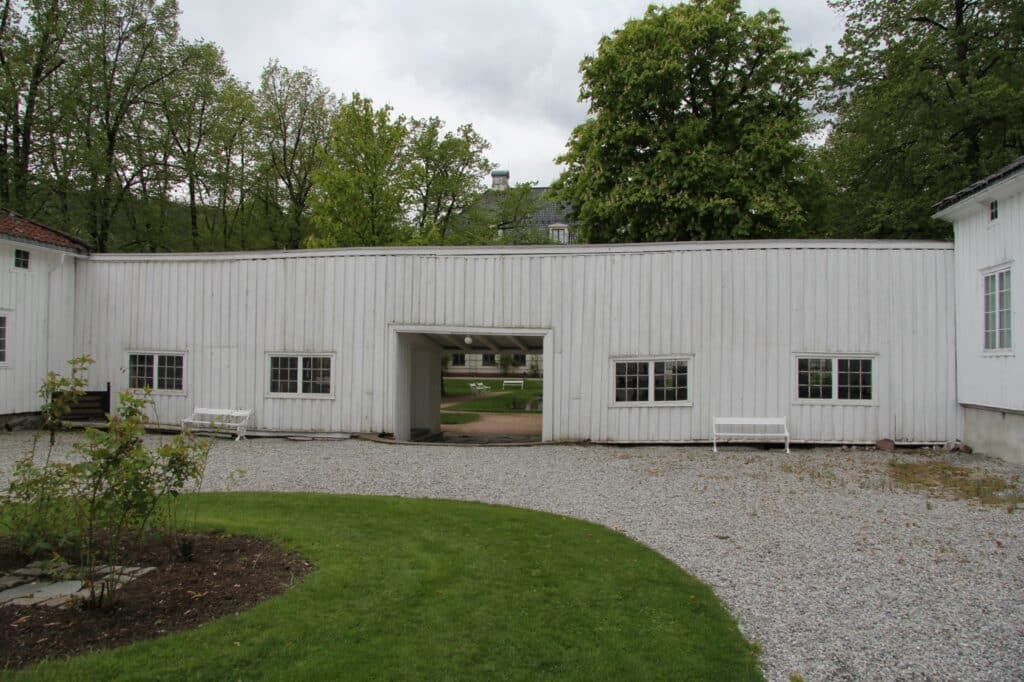
The condition assessment Løken Bygg has carried out of the buildings themselves will give us the basis for the important choices to be made further in the restoration process. Here the focus will be on the West Wing with so-called condition level 3. The building has major settlement damage and has sunk by between 5 and 15 cm.
The recommended measures are comprehensive and show how complex this project is.
Among other things:
- Disassemble windows and doors for repair and restoration
- Disassemble roof tiles to supplement corresponding tiles
- Disassemble and refit floorboards and other building parts and replace rot-damaged parts of the construction
- Disassemble, supplement and refit parts of the external cladding
- Establish new foundations to raise and straighten the building as close to the original as possible.
At the end of the 1920s, an opening was made in the West Wing from the courtyard in the axis towards the Museum's new main building. This is the cause of much of the failure in the load-bearing structure.
The restoration works are well suited as course subjects since much of the damage does not require special equipment or complicated solutions. The material costs will be relatively modest, since much can be reused. Here we therefore have an important and current entry into the dissemination by emphasizing traditional crafts, something for which there is great and growing interest. One example is the production and restoration of building parts that can be carried out with simple craft tools on site. Emphasis is placed on quality materials being sourced from local suppliers. Existing building materials must be reused where possible. Collaborating partners will be the Institute of Handicrafts, the Historical Heritage Association, students in construction subjects at upper secondary schools and Buskerud Bygingsvernsenter.
Sustainability becomes an important aspect of the project on several levels. Here we can highlight the reuse of materials and building parts, localization of the project on site, arrangements for more people in the local environment to participate regardless of finances and, not least, safeguarding and making available an important cultural heritage. The project will include collaboration with many resource persons in various professional environments. The collaboration will provide important synergy effects and form the basis for important local networks in knowledge production, knowledge sharing and preservation of the tangible and intangible cultural heritage.
The museum has solid experience in establishing a learning arena for restoration and immersion in traditional crafts, particularly through the project with the restoration of the barn from Straumen at the Open Air Museum in 2020. Here, the collaboration with local schools for courses in travel and restoration was central with a view to knowledge transfer. The process of refurbishing Marienlyst will also create a renewed understanding of the building's history, not least because of the documentation that is done along the way.
A workshop and display room in the West Wing will become an important dissemination arena for various craft techniques.
Here we will also tell the supervisor about the Marienlyst project in the various phases, a story that will be relevant for a long time to come. We will also exhibit current items from the collections such as tools, preserved parts of wallpaper and rare building parts.
Traditional crafts and various crafts are thus a key word for both the building mass and the renovation of the interiors. All this creates a web of stories that create a whole in the dissemination of the project. In extension of this, we are planning temporary exhibitions in the North and East Wings as a learning process for the development of a main concept for permanent exhibitions and other events in the facility. It is currently appropriate to have one project per year which will be based on Marienlyst and current objects from the collections. All events and exhibitions must be in direct dialogue with Marienlyst, the buildings as a setting and the history of the facility.
The communication and learning potential of the project
The overall strategy is to communicate this unique project during the restoration process in order to create an understanding of the importance and scope of the work to be done going forward. There is great communication potential here, especially for children and young people as an important target group to be able to continue to tell the story of Marienlyst for future generations with roots in Dramme's history and local identity.
We are looking ahead, but an important part of the project is also to document the history and to transfer knowledge via courses in traditional crafts and small and protected crafts. This gives us an important and up-to-date introduction to the dissemination.
What can we concretely do for children and young people?

At the Drammens Museum, there are a number of programs in the Cultural School Bag. When the museum's museum educators create a teaching plan for children and young people, they take the curriculum for social studies and arts and crafts as their starting point.
In the teaching plan, the focus is on introducing the students to a theme, conversation and activating the students.
Here, there are many themes and activities that can be communicated based on the amusement park facility. Development of an understanding of traditional crafts and small and conservation-worthy crafts will be an important learning arena for children and young people in line with the curricula
Here, among other things, it is relevant to include aspects of NIKU's further research in the main project: Bringing back original colors is a communication strategy to tell about the vanity of the private owners throughout history and the beautiful, but often dangerous materials the upper class used to surround themselves with signal wealth. Few could afford this.
Naturally, we can also draw in social history here. This is something the museum educators have already thematized at Austad and in the permanent exhibitions at the museum. They see a very large potential in extending this to the Marienlyst plant. Digging back in history by peeling away one layer at a time can be as exciting as archaeology.
The museum organizes the Children's Art Club eight times a year. The program for the Children's Art Club at Marienlyst on 12 November 2023 set a visitor record. The educators started with a round in the East Wing. The children were allowed to walk around and wonder and think aloud. Who has lived here? Children? How many? What were their names? Did one or more families live here? What did the adults do? "What is there for something?". This scheme is to be continued and further developed in 2024.
NIKU
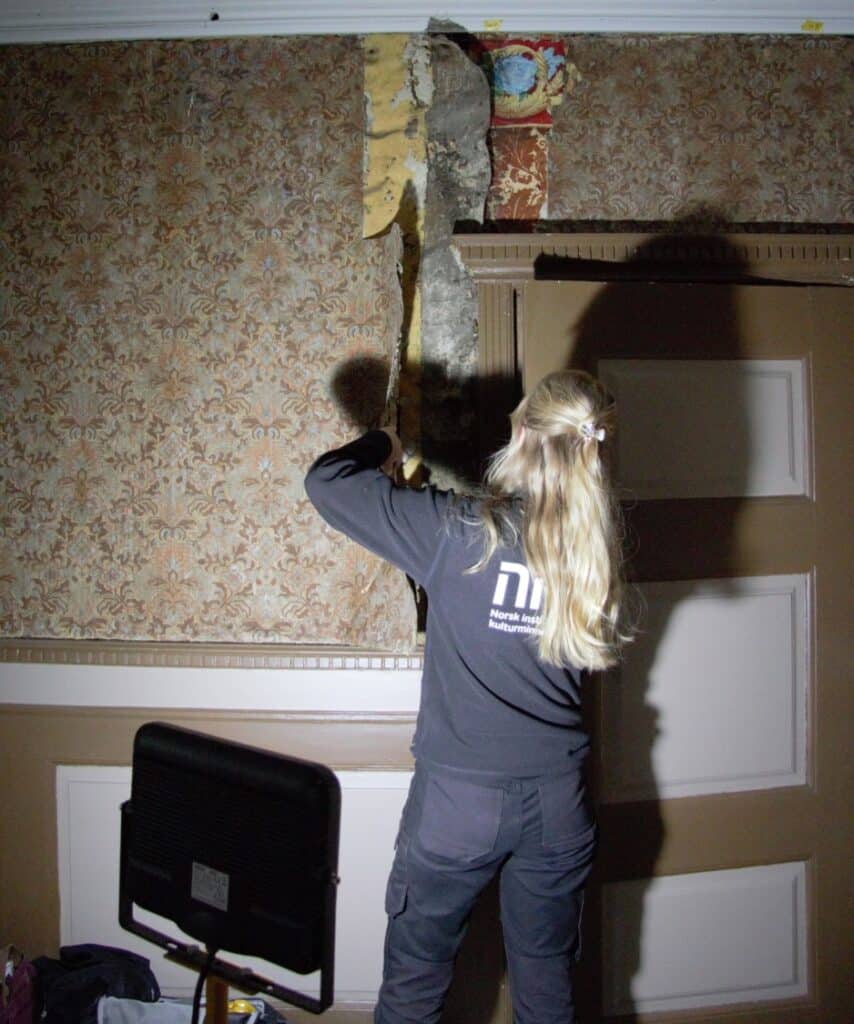
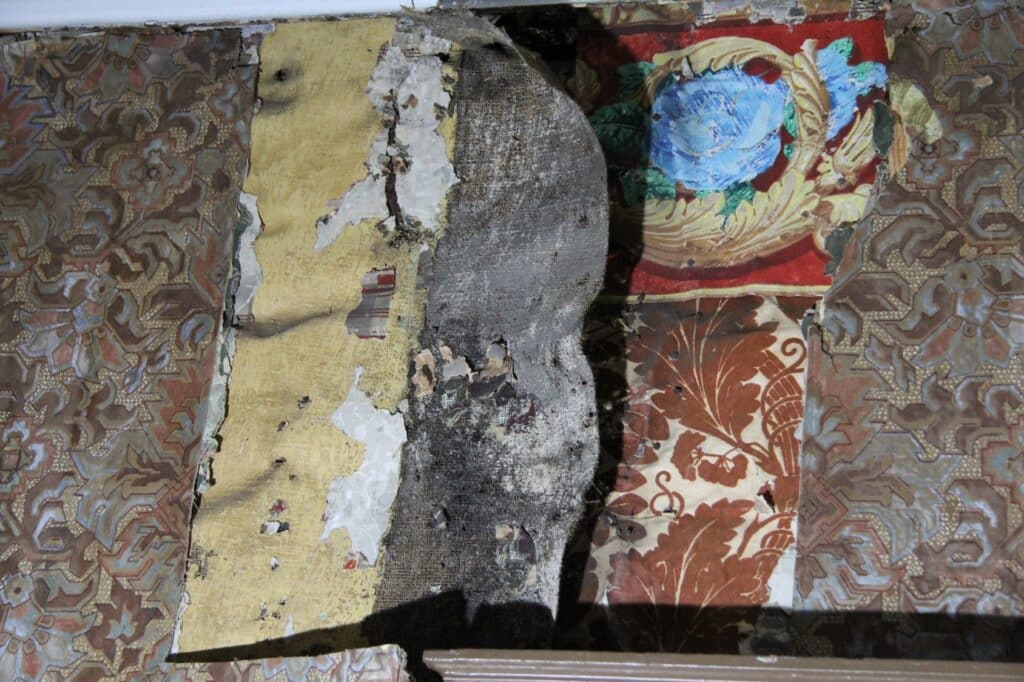
The museum has started a process that consists of various sub-projects. In the spring of 2023, the extensive work of emptying the East and North wings, where the style-historical exhibitions were located, was completed. This was absolutely necessary so that NIKU (Norwegian Institute for Cultural Heritage Research) could begin a preliminary project which involved investigations of the interiors to find a return to original colors and wallpaper. They have carried out analyzes of pigments and selected wallpapers and building elements in the East and North Wings.
The conservators from NIKU see great opportunities in the restoration project at Marienlyst. It is an advantage that the unique building complex became a museum as early as 1911, i.e. 112 years ago this year. Thus, during the museum's ownership period, no major interventions have been made in these unique buildings, following what was done by rebuilding in the museum's first phase. The historical traces are many, and we will therefore find new and valuable knowledge about the interiors. We are simply standing with a treasure chest right in front of us!
The purpose of the assignment to NIKU is to give the museum a documented overview of the building's history, which investigations and which measures we should take in the future. This entails an invaluable professional basis for choosing artisanal methods and not least the use of traditional materials. This will also help us to map which small and conservation-worthy crafts are needed in the next phase. In the preliminary project, a limited survey of selected rooms has been carried out. The purpose has been both to document these rooms, and to get a general overview of how much has been preserved and what we can find.
In the East Wing, two rooms have been investigated: the Empire room and the Moe room. The investigation has shown that the rooms were originally one room that has been joined together. Later, the entire room received the velor wallpaper, which was recreated in the Empire room in the 1990s. The partition wall was probably put up after 1847. We know this because the Moe room was then wallpapered with a stamped wallpaper from the Norwegian manufacturer Frølich "Tapet-Fabrik.FH Frölich Christiania", which was founded precisely in 1847.
In the North Wing, three rooms have been examined: the Great Room, the Living Room and the Visiting Room. The rooms have of course had different names throughout history, but I use these designations for the sake of simplicity. In Storstuen, it is likely that so-called auripigment was used in the first layer of paint. The name comes from the Latin meaning gold dye. The pigment, which is lemon yellow, is unstable and highly toxic as it consists of arsenic and sulphur, among other things. We will of course use a non-toxic version in the event of a return. The living room was probably dark red. NIKU also has expertise in traditional crafts such as reconstruction of colors and wallpaper, gilding and restoration of building parts. This represents small and conservation-worthy, actually endangered, crafts. Norway has undertaken to take care of these subjects through the Unesco Convention on the Protection of Intangible Cultural Heritage, which entered into force in Norway in 2007.
Other professional communication

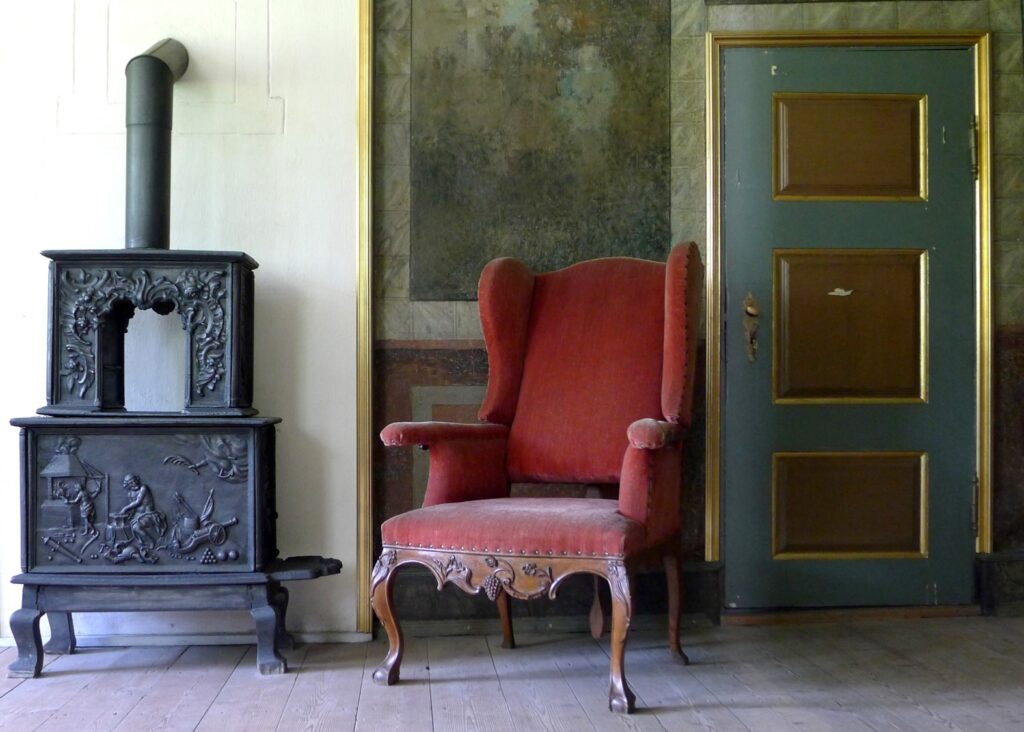
In addition, we create great and enthusiastic interest in the project via participation in the national and international Manor Network, including contributions such as presentations at seminars. We have extensive contact with professionals in the network.
We have also started current basic research on objects and archives in the museum's collections, Drammen City Archives, and in archives at the National Library and the National Museum. This documentation is an important part of the history surrounding Marienlyst with a view to writing both popular science articles and articles for peer review for publication in professional journals.
Digital comunication
Time to think about Easter tea?
We follow up the theme of Marienlyst and impulses from Europe with a separate chapter on tea machines.
There was a large import of goods from England in connection with the so-called licensed trade. In 1807, Great Britain entered into a war with Denmark-Norway, and from 1809 letters of credit were granted to Norwegian vessels that brought timber from Norway to Great Britain. License shipping, which was a direct consequence of the Napoleonic Wars, therefore became of great importance for Norwegian timber trade and shipping in the period 1809–1912. The tea machines often came to Norway together with other return goods when the important timber loads had been unloaded in English ports.
A tea machine is most often urn- or ball-shaped, made of copper, brass or silver. Through the container runs a vertical, thick tube with a damper at the bottom and a cap at the top. Charcoal is filled into the pipe, which heats up the water in the container when burned.
When the use of tea machines was at its height in the last decades of the 18th century and the first half of the 19th century, the selection of tea was a little more limited than today. We can safely say that Easter tea and Christmas tea are a modern phenomenon. Toll lists and newspaper advertisements say that it was mainly Chinese tea that was imported to Norway: Congo and Bohe tea, eventually also the varieties Imperial, Hysan, Haysansehin and Pouchong. This tells us that Norway was part of a worldwide trade network.
In Drammens Museum's collections there are a number of examples of tea machines. One of the best-documented is of Sheffield stain, a gift from Peder Anker to Caspar von Cappelen who ran a timber trade at Bragernes. They both donated 10,000 riksdaler to the founding of the Royal Frederiks University. As a memory of this, they presented each other with a tea machine. In the photograph, Anker's gift to Cappelen is on a chest of drawers in Hans Malling's living room at Marienlyst. In theory, Malling could have been included in this gift exchange, because he too donated 10,000 riksdaler to the university project. The tea machine can thus be linked directly to the story of Marienlyst in the golden age of the merchant patricians. The exhibition was dismantled in the spring of 2023 in connection with the rehabilitation of the amusement park facility.
In many ways, the tea machines represent the 19th-century bourgeois public, both as a technical device in the century of machines and as a meeting point for enlightened citizens. They simply created a new meeting place for freer political conversations.
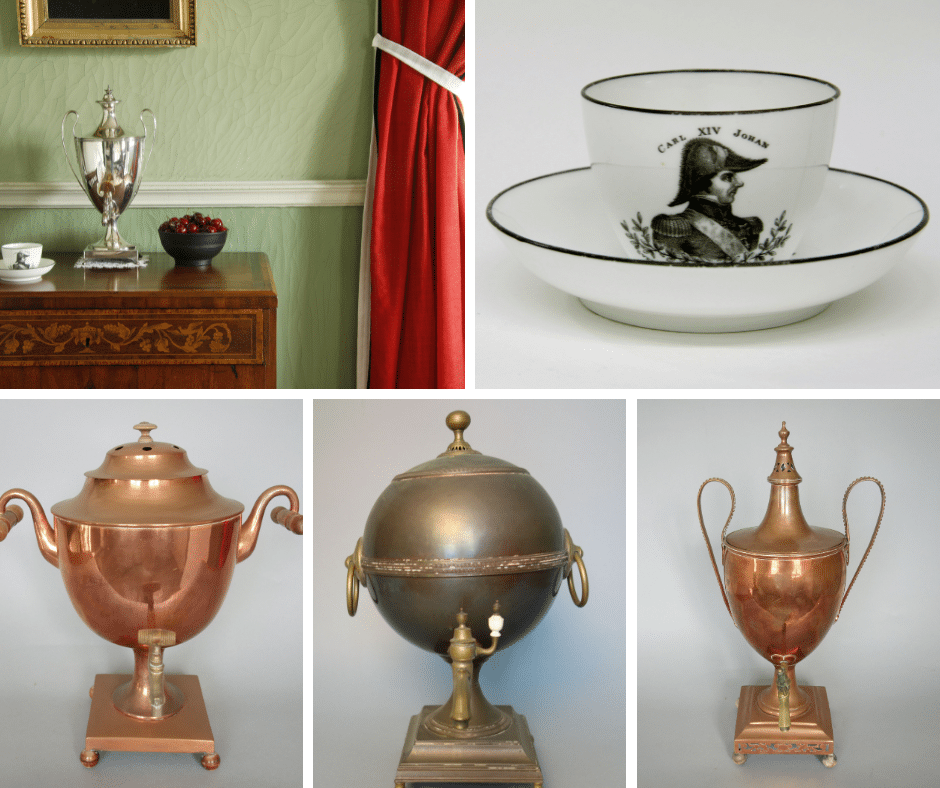
More chapters with dissemination from Marienlyst:
Marienlyst and impulses from Europe

The story of Marienlyst reflects both the history of Drammen, the history of the region and the history of Norway. Not least, we can draw in the connection to the great outdoors. The history of the city begins in the Middle Ages, and we can actually trace the lines back to Marienlyst opened as a museum in 1911 and even further. Here, Drammens Museum's yearbooks are once again an important source for documenting parts of history. The archaeologist and museum man Sigurd Grieg writes the following in the article "Senmiddelalderske funn fra Drammenselven" printed in the museum's yearbook 1928-1933: "Drammen's old trade connections must be sought in the cities of northern Germany and the Netherlands." The important timber export to Germany, the Netherlands and England, and the import of goods from all over Europe took place from Drammen. The harbor was the heart of the city. As it can also be said to be today.
In the city, an object culture developed based on luxury goods and a modern lifestyle. The interiors of the high bourgeoisie followed European fashions which determined the forms of social interaction and opened up new social codes, including visits where coffee, tea and wine were served for entertainment. In short, Drammen became a national and international hub. In Drammens Museum's yearbooks and collections, we find examples of imports of exclusive fabrics, among other things. A French or English dress from the 1750s is sewn in green silk damask with interwoven flowers in silver grey. The museum also has a so-called robe à la française from about 1760-1780 in silk damask from Spitalfields. Both suits have a cut that was the highest fashion in England and France at the time. The collections include French wallpaper and porcelain from China and Denmark.
The local artisan guilds also represent European role models. The quality of what was made locally is high, often with a strong influence from abroad. The prosperity and ambitions of the merchant class grew. They bought expensive furniture for their homes in Bragernes and Strømsø, and we must be able to assume that some of the imported furnishings also ended up at Marienlyst: crockery, tea machines, beautiful cabinets with silver inlay, lacquered cabinets with china series and carved gilded lion feet.
It was not only material, but also ideological-historical impulses that were imported from abroad. Councilor Tønder, who owned Marienlyst from 1795 to 1808, read both Voltaire, Rousseau and Diderot. The painted tapestries at Marienlyst show a selection of the senses and virtues and the gallant customs of the upper class. Here, too, we can draw in the influence from Europe via planar works and copper engravings that were used as templates. We are simply talking about art historical imports.
That Drammen at the beginning of the 19th century underwent a sweeping change from a trading town to an industrial society with a large working class and nouveau riche industrial owners underlines the history of the downfall of a social class. This is also reflected in the changes in ownership at Marienlyst: The prosperity at Marienlyst under Weyer and Tønder and then Malling's growth and bankruptcy was a direct result of the trade blockade during the Napoleonic Wars. And that was the end of Marienlyst's golden age as an amusement park for families from the upper middle class in Drammen. And with the downturn came a sobriety that called for an emphasis on the local production of consumer goods. The 18th-century penchant for luxury products from Europe was thus a thing of the past.
Christmas at Marienlyst
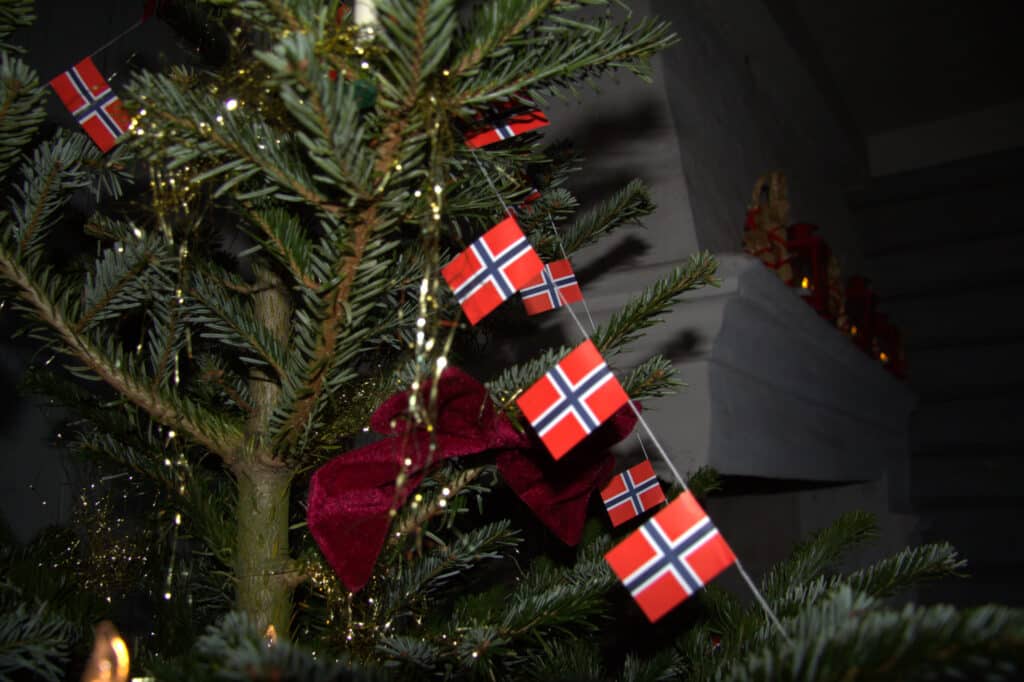
In the East Wing at Marienlyst, we decorated a Christmas tree for the Christmas market in 2023. We started from historical traditions: The tree had glitter and Norwegian flags, homemade bows and kremmerhus and a shiny spire at the top, as you would see it in a bourgeois home from around 1910 .This dating agrees well with the history of Marienlyst since the plant was sold to Drammen municipality by the Fuglesang family in 1909.
Most people could not afford the surplus phenomenon a Christmas tree actually was. The tree was to be decorated and it was preferably to be hung on gifts, which was beyond most people's financial reach. Thus, this Christmas custom also becomes an indicator of social status. The tradition of decorating Christmas trees in Norway goes all the way back to the first half of the 19th century, introduced by wealthy bourgeois homes and not least by the priests.
We know, among other things, Gustava Kielland's Christmas tree from 1840 at the rectory in Lyngdal. She describes the tree as follows: "The Christmas tree [was] well decorated with homemade candles, sprinkled with large yellow and white Evergreens from Haven, decorated with silk ribbon, hung with apples, garlands of raisins drawn on wire and almonds in the paper net and provided with simple [simple] Gifts”. This agrees well with what we know about the Christmas customs of the upper class. For most people in Norway, it did not become common to have a Christmas tree until the end of the 19th century, when the decorated tree became the central focus of Christmas.
Christmas tree decorations have naturally followed fashion throughout history. They have used what has been available, both handmade and mass-produced, from homemade links and baskets made of glossy paper to gnome figures and shiny and glittering (and easily breakable) balls, usually in well-matched color shades. Now it has also become more and more common to use artificial and thus very practical Christmas trees. But our lightly sprinkling and spruce-scented Christmas tree at Marienlyst reminded us of the historical Christmas customs - even if the candles used were not live, home-cast tallow candles, but were lit with a highly modern remote control.
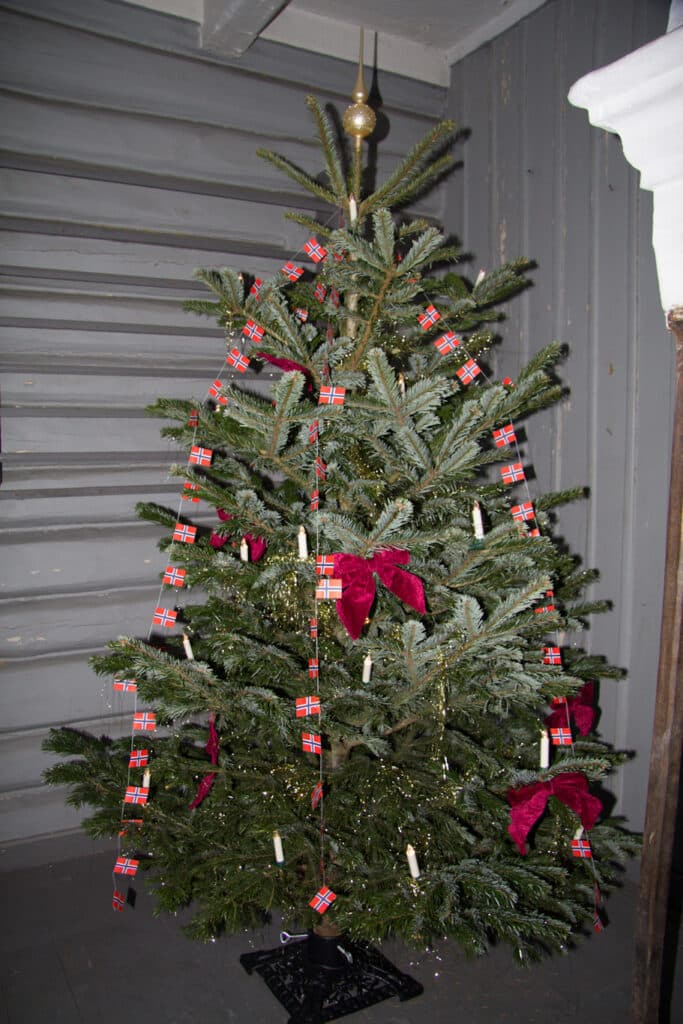
Great visit in Drammen - and at Marienlyst
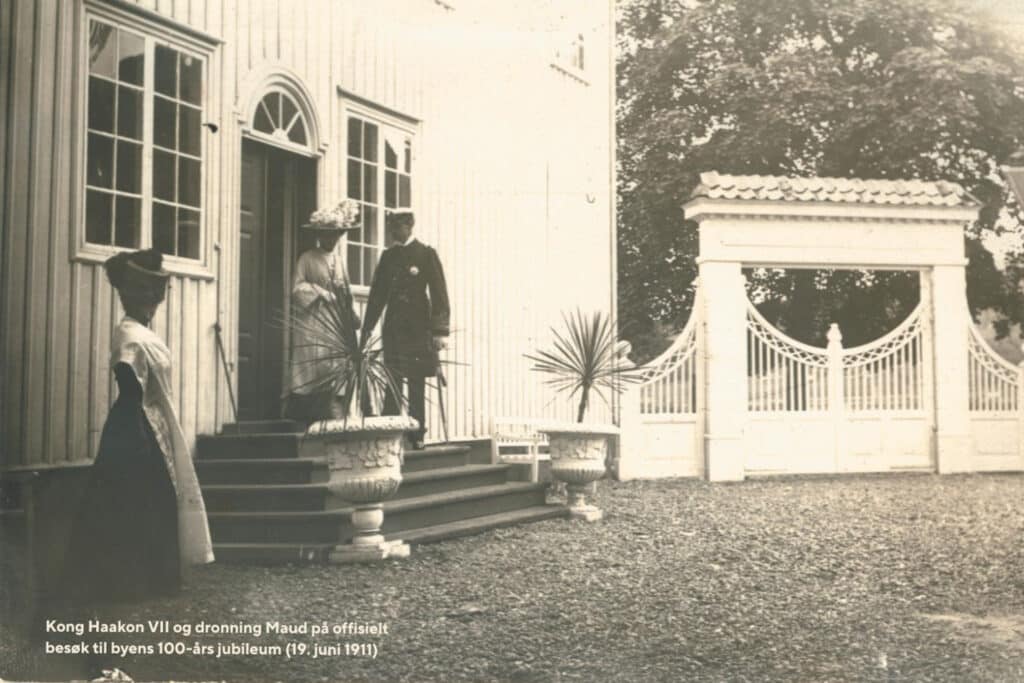
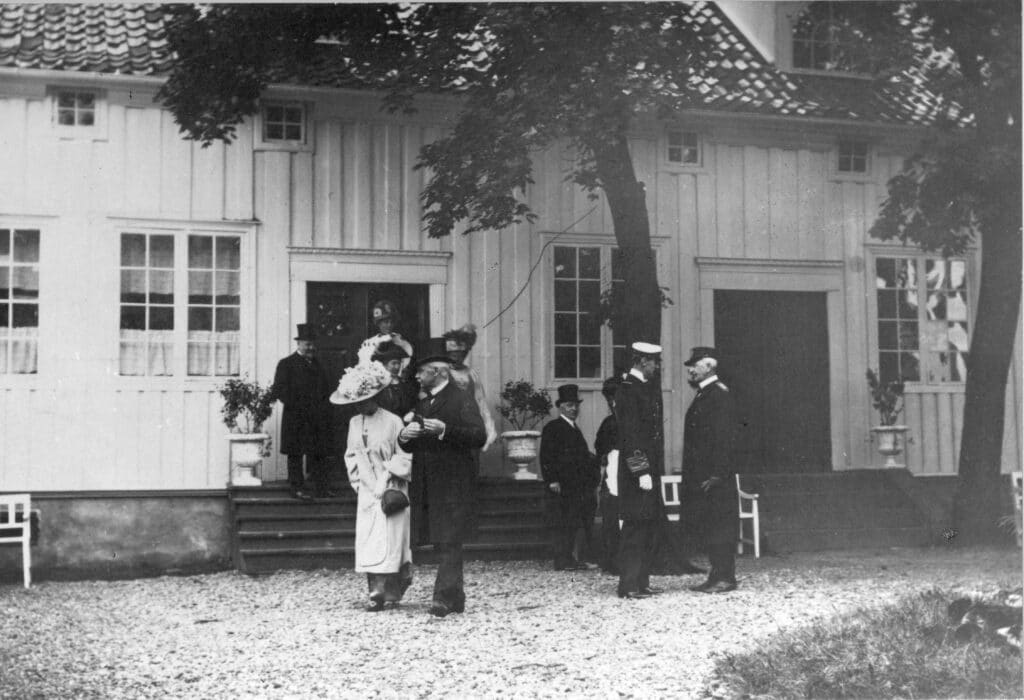
This time we take a small detour before finally ending up at Marienlyst. We thought it might be appropriate to tell about a great visit to Drammen. There is a long tradition of royal visits to the city. During the Danish era, in the union with Sweden - and after the dissolution of the union in 1905. In the Danish era, a royal visit was a grand affair, with a large entourage and pomp and splendour. In the 17th century and beyond into the 18th century, it was naturally Kongsberg that was the main target. The silver works accounted for significant income for the twin kingdoms of Denmark and Norway. When King Christian IV founded the mountain city in 1624, he traveled via Bragernes In the same year, the royal road from Kongsberg was built as Norway's first public road. The town was dependent on food supplies, and the road ran from the import port in Drammen.
Later, almost all the Danish kings traveled to Kongsberg via Bragernes. This reminds us that the city had one of Norway's most important ports, which in turn was the reason for the boom in commerce - and which thus had the finances to build a pleasure yard like Marienlyst.
And then we have to bring in the architect Christian Staalberg. He was one of the early architects in Norway who had an education from the Academy of Fine Arts in Copenhagen. In Drammen, he received public and private commissions from the end of the 1780s until about 1810. It is believed that Staalberg was also responsible for some remodeling of Marienlyst under Justice Council Tønder in the mid-1790s. The two symmetrical wings were connected to the main building by two gates in the style known as "Louis-Seize". He probably also designed building details such as door moldings and chest panels. There are many similarities here with the interiors at Gulskogen Gård, where Staalberg was the executive architect.
As the last of the union kings, King Oscar II visited Drammen in the early 1890s. The dissolution of the Union was a fact on 7 June 1905 and on 15 November of the same year, the Danish Prince Carl became the elected king. He took the name Haakon VII, and arrived in Kristiania ten days later together with Queen Maud and little Crown Prince Olav. The new royal family immediately became enormously popular. They shed light on a number of events in the time that followed. In 1908, King Haakon was also in Kongsberg and unveiled his monogram on the rock wall called Håvet. There we find the monograms of all kings who have visited the city.
Some of the most iconic photographs in the museum's photo collection were taken when King Haakon and Queen Maud visited Marienlyst during the opening of the Drammen Museum and the celebration of the city's jubilee on 19 June 1911. The king is in a navy uniform, and Queen Maud is, as always, elegantly dressed in bright summer clothes. And here we see precisely one of Staalberg's gates from the 1790s in the background on the left.
Party and fun at Marienlyst
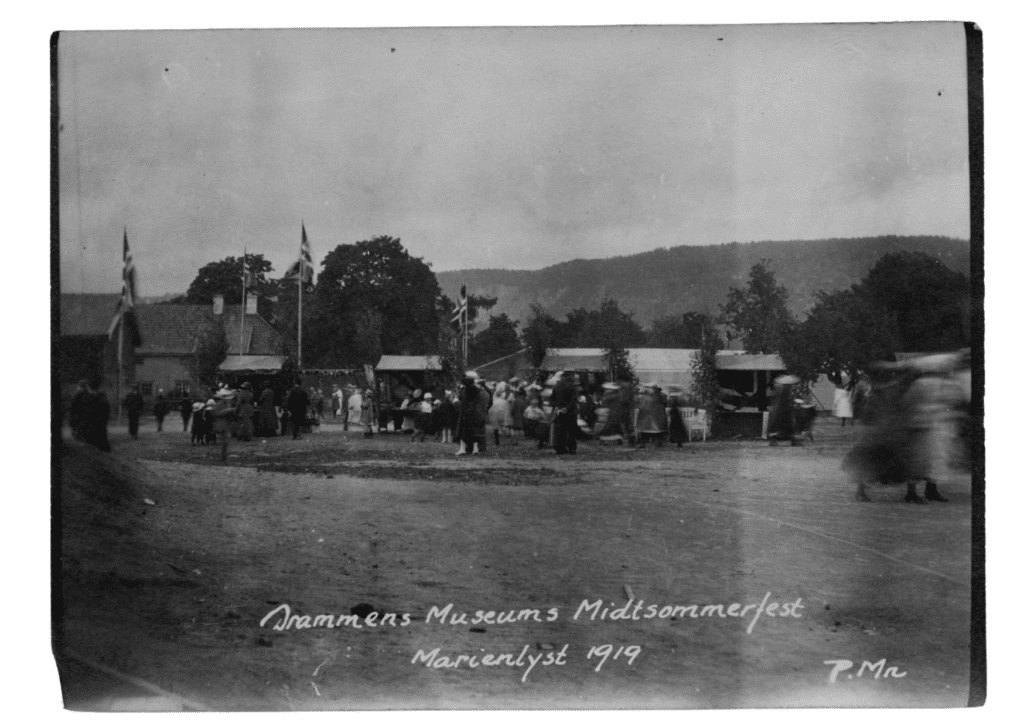
When King Haakon and Queen Maud were present at Marienlyst during the opening in 1911, everything that could crawl and walk off the city's notables was in place. But this was in a fairly formal context and, judging by the photographs, it was very appropriate for him.
In 1919, the museum organized a summer party, with a large influx of public. There were sales stalls and a carousel and the Norwegian flag was raised to emphasize the atmosphere of celebration and fun. We can probably count on the event to be a bit more relaxed than during the royal visit eight years earlier.
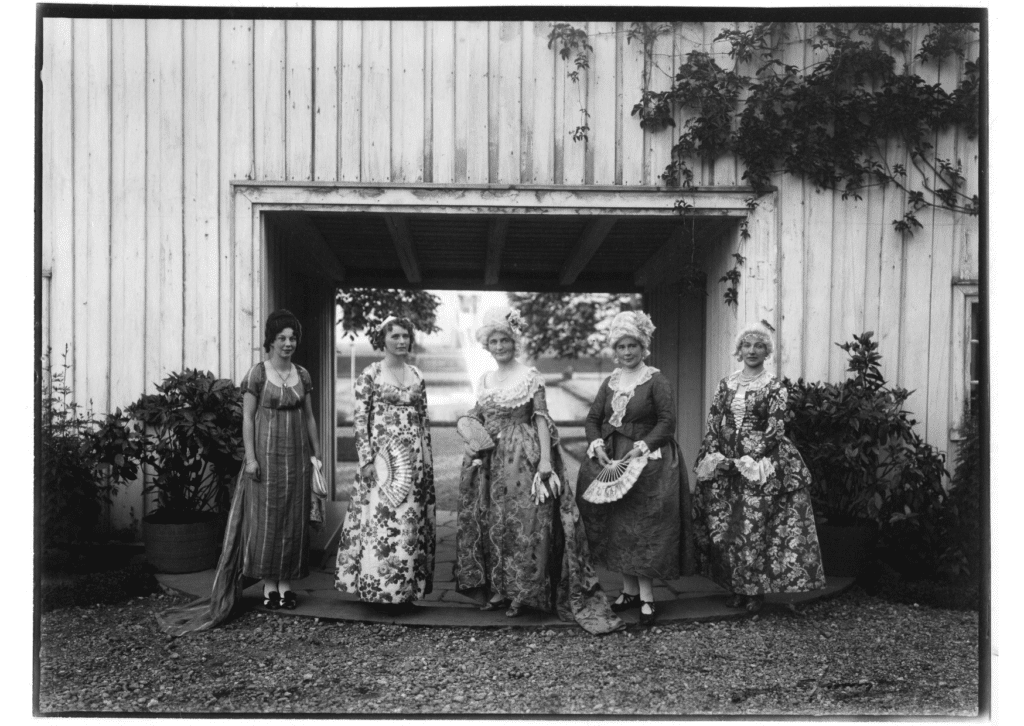
And in 1933, five ladies from the friends' association were photographed in front of the West Wing at Marienlyst. They were wearing original costumes from the collections, including a dress from the 1730-40s in green silk brocade with matching shoes. It is unknown if ladies' feet in 1933 size were pressed into them. In any case, we have no description of the condition after use. In fact, they were not so careful about it at the time, in contrast to today's strict conservation practices. The occasion was a tour for the association of friends in the museum's new main building, inaugurated in 1930. Then refreshments were served in the Great Hall in the old building, where candles in crowns and stakes were lit, and where the table was covered with old silver and faience.
Costume parades with original outfits from the museum collections were common right up until the 1950s. At the Kunstindustrimuseet in Oslo, great soirées were arranged with old dresses and uniforms. But they were probably a bit small in size, because several of them burst at the seams.
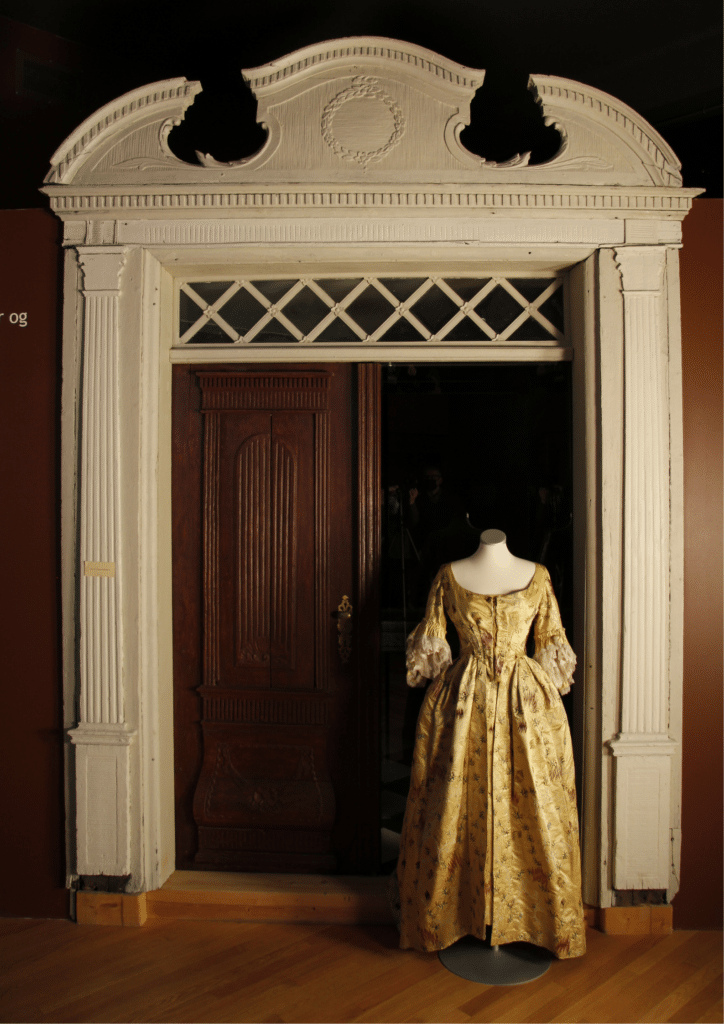
In connection with the museum's activities, in the 1920s several amateur performances were organized in Drammen's theatre. These brought in a good chunk of money as income for the new main building at the museum. The performances were open to all paying members, but the slightly more exclusive dance evenings in Børsen were for a narrower circle.
The contributions to the building project became noticeably smaller as a result of the economic downturns at the end of the 1920s. But there was nothing to say about the commitment among the people of Dram for the new building at Marienlyst. And there was great celebration when the museum was finally able to open in the new premises in 1930.

Marienlyst becomes a museum - and Anneken Pettersen becomes conservator and director!
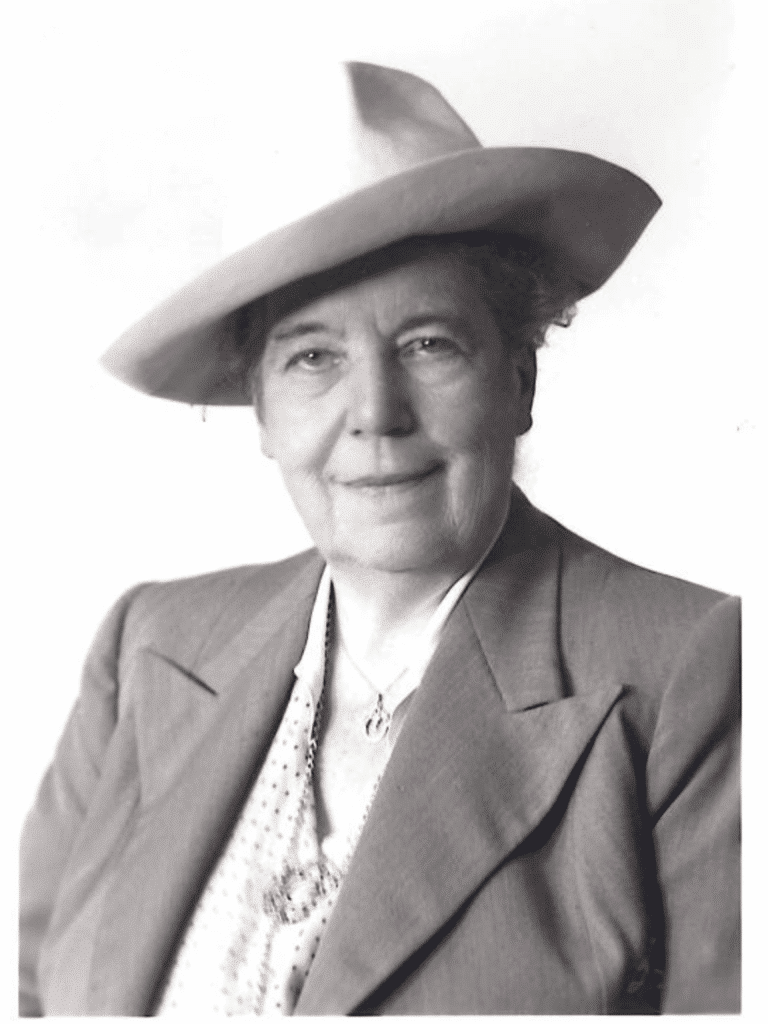
When the Drammens Museum moved into Marienlyst in 1911, the extensive collection consisted of approximately 2,200 objects. A selection of these were to be exhibited in the educational style history exhibitions in the North and East Wings. But the rest needed storage space. We find details about the objects in the museum's old protocols, where they are entered in neat handwriting with a number and description.
Already early in the museum's history, there were plans to build a new building that would enable temporary exhibitions, house the administration, conservation studio and, not least, be the final solution to the storage problems. It was not until 1930 that the main building, designed by architect Christian Fredrik Arbo, was inaugurated. But the problem of lack of magazine space continued.
The museum's first special exhibition opened in October 1923 in the Kunstforeningen's premises in Børsen precisely because of the lack of space at Marienlyst. City prospectuses, photographs and measurements of old buildings in Drammen and the surrounding area were shown here.
In the first decades, the museum did not have a director, but a "Management". For a number of years, this consisted of, among others, chief prosecutor A. Juel (chairman) and chief prosecutor C: O. Lund. Another name that appears early on is Anneken Louise Pettersen. In the yearbook from 1918 under the heading "Museet's board and staff" it is written that she carries out "museum work". In the same year, she was appointed conservator. She contributed a number of long and scholarly articles to the yearbooks, a result of her research into the museum's collections
Anneken Pettersen also collaborated with several people who were to make themselves known within the Norwegian museum field in the interwar period. When the first floor of the North Wing at Marienlyst was to be furnished with a style-historical interior exhibition from the period 1780-1840, "Mr. conservator" Thor Kielland brought in as professional expertise. Kielland later became director of the Kunstindustrimuseet in Oslo. We must also mention professor and art historian CW Schnitler, who had been Pettersen's teacher in art history at the University of Oslo. He researched Gulskogen farm's history, and we must be able to assume that Pettersen was a resource during this work.
For a number of years, Pettersen's official role was rather secluded compared to her male colleagues. But it was she who, in 1946, became the first at the museum to receive the formal title of "director", as the very first woman in Norway. And thus Drammens Museum has helped write women's history!
The residents of Marienlyst

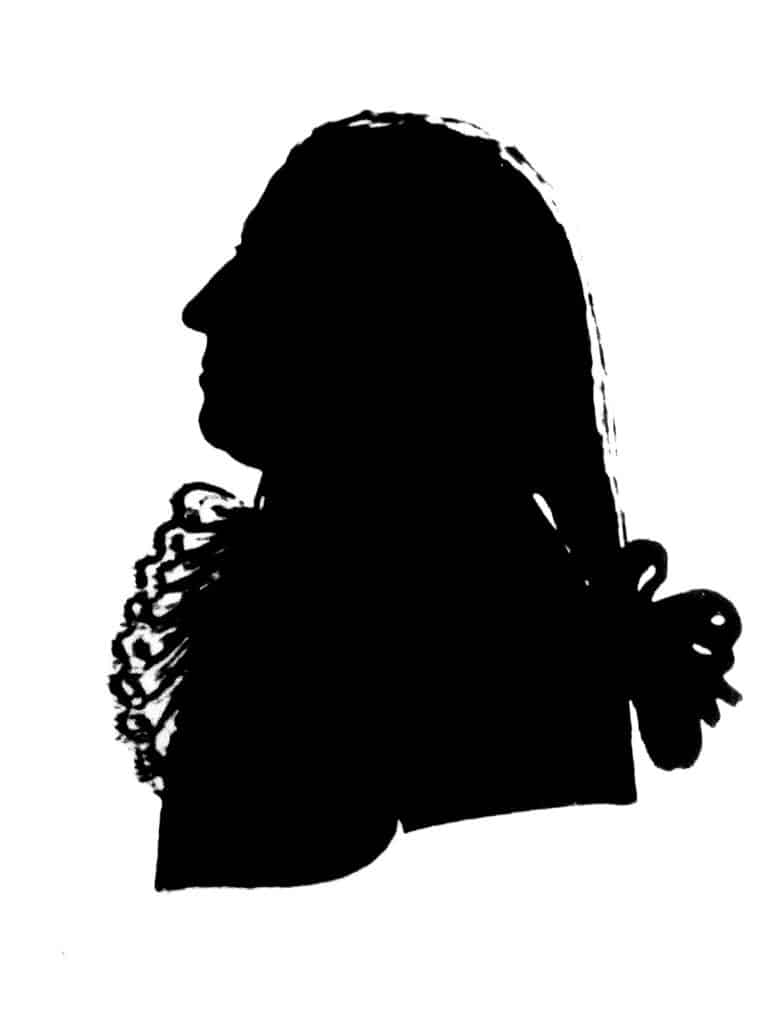
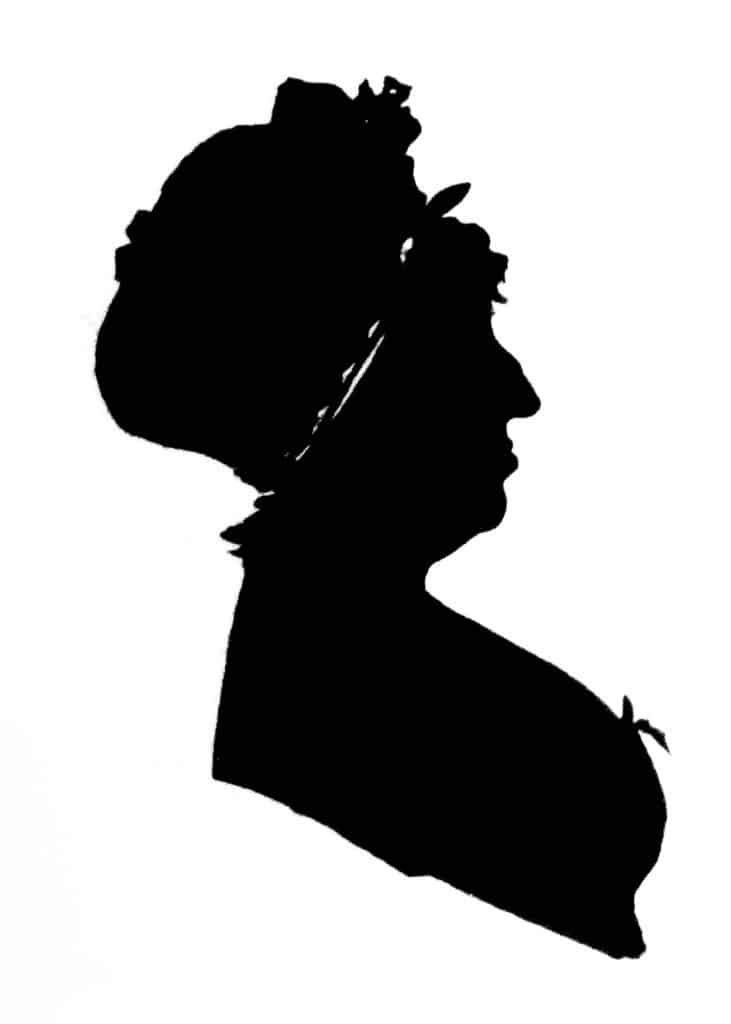

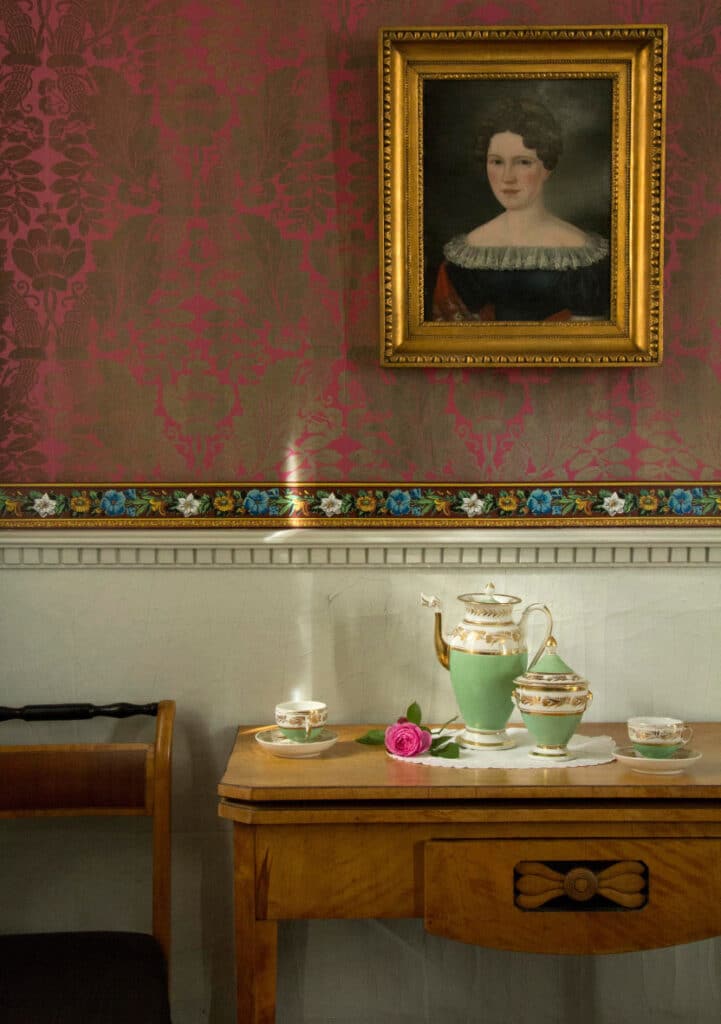
We would like to get to know the people who can be linked to the story of Marienlyst better. They were all people of their time and can help us to understand the facility better, also as a small piece of social history.
For now, we know mostly about the main characters and not the servants, farm helpers and householders and others who were connected to the operation. These have mostly gone down in history as anonymous, but are mentioned by name in the censuses.
The story begins with Else Angell (1710-1787) and her acquisition of properties. She became a merchant's widow early on Albert Angell (1697-1746), and was an enterprising lady!
The property is then taken over by the harbor bailiff and war council His Thomas Weyer (1721-1790) and Mrs Magdalena Weyer (1732-1819). Weyer is building the pleasure garden here Weyersfryd where he and his family could withdraw from the public eye. The buildings get their current design between 1770 and about 1780, including the gazebo..
Council of Justice Hans Heinrich Tønder (1738-1808) buys the plant from Weyer's widow in 1795 and renames it Tøndersfryd. His ownership period is called "Lystgården's culmination". Tønder was eloquent and inquisitive and characterized by the ideals of the Enlightenment. He stood at the top of the social hierarchy, and practiced extensive sociability as befits a man of his class background. He never married.
Grosser His Malling (1748-1816) and his wife Marie (1751-1820) takes over in 1808, and the plant remains in the family's possession until 1843. It is now that the plant gets its name Marienlyst Malling runs a trading business on Strømsø. A large timber business made him one of the city's richest men during "the so-called golden period around the year 1800. But then there are hard times and bankruptcies as a result of the conjectures during the Napoleonic Wars. The Malling family will feel the ripple effects of this.
The farm is sold by the family in 1843. The buyer is a commercial gardener Jørgen Knudsen (1806-1862), "Knudsen på Enga", who builds a large horticulture and plant school on the property The municipality took over the management of Marienlyst after Knudsen's widow Anne Margrethes (1786-1870) dead, and sold it on to a textile manufacturer Jørgen Birdsong (1809-1877) in 1873.
And then, optimistically enough, Marienlyst was bought by Jacob Styrmoe (1823-1886), mayor of Skoger and brewery owner. But he had simply taken water over his head and turned out to be insolvent. The municipality stepped in as a buyer and made the property available to the Drammen Museum in 1909. The exhibitions at Marienlyst opened in 1911, for Drammen's 100th anniversary.
The garden at Marienlyst
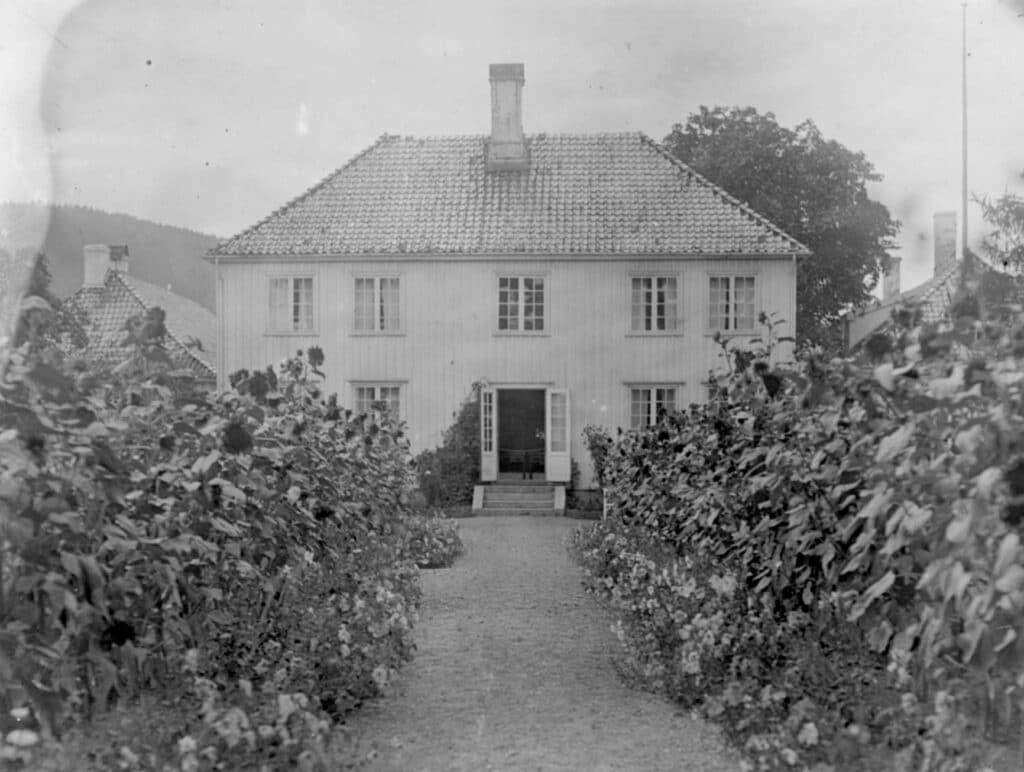

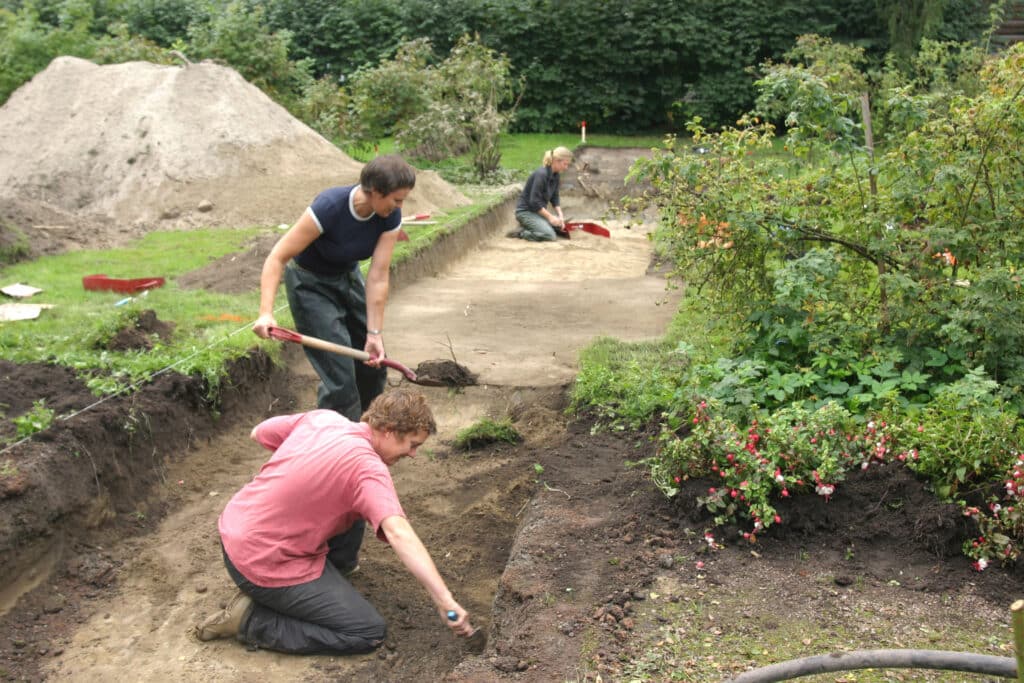


The garden at Marienlyst was part of the pleasure garden complex that was completed around 1790.
The planting has varied considerably over the years. In 2004, a garden archaeological excavation was carried out to investigate what changes the garden had undergone and whether the walkways had always been in the same place as today. The excavation showed that the crossing walkways that divide the garden into four so-called quarters and the enclosing road had been there all along and were covered with sand and river gravel.
Inside each of the quarters, no structures were found in the soil layers, but in the south-west quarter, a buried bottom was found, probably the foundation for a water tank. This has been reconstructed. In the north-west quarter, buried horse dung was also found in three rows which probably served as heating beds for demanding plants such as palms and pineapples (!).
Today, the facility is organized symmetrically around a main axis, typical of classicism, with international models from, among other things, the garden at Versailles, which was laid out in the 1630s. The axis starts at the garden door in the East Wing and runs in a straight line towards the gazebo, which forms a central motif.
The gazebo is from around 1780 and originally formed the transition between the private garden and the landscape outside, which was previously open towards the city. We must remember that Marienlyst was outside the city center at the time, long before the regulation of Bjørnstjerne Bjørnsonsgate came.
During the 2006-2008 renovation, which was paid for by Sparebank Øst, they built on what was found and what could be maintained following the example of the high standard from the 18th century. The plan was drawn up by gardener Jan Høvo and combines flowers and a herb garden. The plants used were common in 18th-century Norwegian gardens. Examples of this include daylilies, daisies, peonies, sage and thyme.
The flower beds are laid out along the central axis, which is edged with cut turf. Along the transverse axis are rows of berry bushes and fruit trees which are also planted along the outer edge of the quarters. A jasmine hedge on the north side provides a demarcation, but the fence used to run along the edge of the walkway. The hedge on the southern side of the garden was planted in the 1920s to separate the garden from Hallingtunet, where there was an orchard in the 19th century. The facility is currently managed by José Arroyo Perez, who has expertise in historic gardens.
Marienlyst becomes horticulture

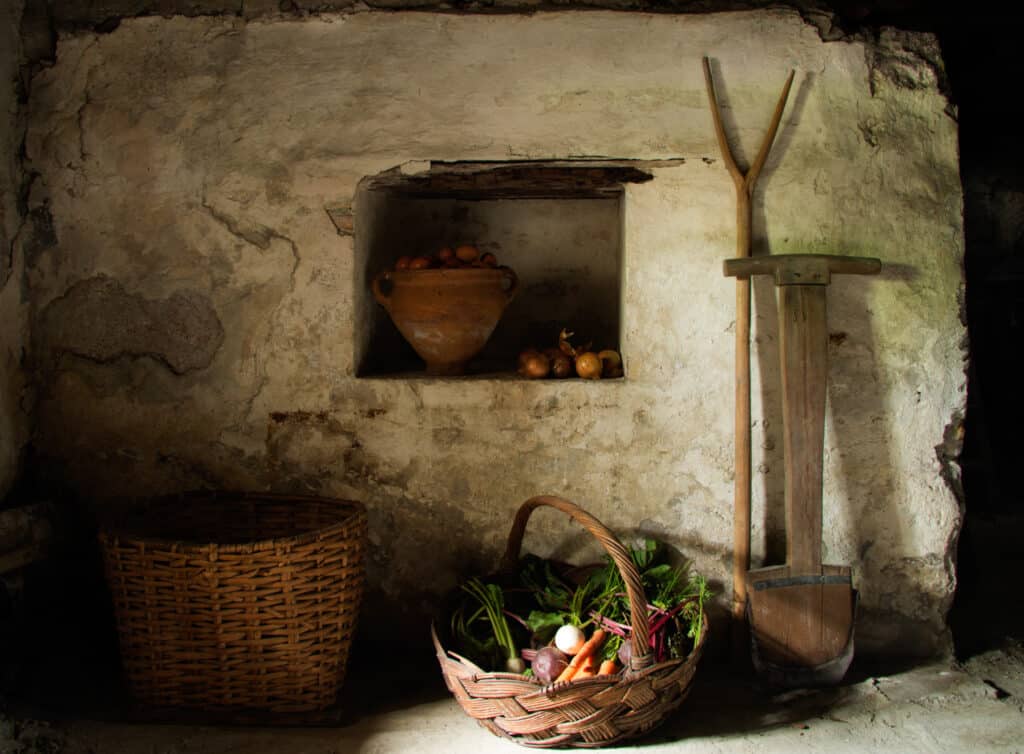

Merchant gardener Jørgen Knudsen (1806-1862), "Knudsen på Enga", bought Marienlyst in 1843. On the property he built a large nursery and nursery which he ran together with his wife Anne Margrethe Knudsen. That's the end of Marienlyst's time as an amusement park.
The import of plants and seeds shows that Knudsen was oriented towards the world outside Drammen in his efforts to obtain attractive plants for the city. The married couple advertised the products in the local newspapers: "English Apricots and Peach Trees, Vines, Extra Good Gooseberries, White Grapes, Currants, Moss Roses, Rosa unica and Rosa Tuscany" You could also buy different varieties of apples and pears, in addition to asparagus, radishes , caraway and salad. In other words, everything you needed to build your own kitchen garden. Perhaps the selection for Knudsen would have been just as relevant today? Among other things, Knudsen also delivered 250 chestnut trees to Bygdø Kongsgård.
On the property, the couple had their own sales stall for fruit and vegetables, the so-called "Knudsehytta". Around the courtyard, on Marienlyst, i.e. in the heart of the facility itself, there was a throng of people in the residential wing, in the kitchen, in the boys' room, in the sheds with storage rooms and in other outbuildings. In the courtyard there was also the water main, which was an important prerequisite for the entire business.
The census from 1865 shows that a total of 40 people lived on Marienlyst and the adjacent Scheitlieløkken. Here we find most of the social classes in society: a housekeeper, maid, an office assistant, a ship owner, a sheriff, a merchant, a master carpenter, a master maltster, a laborer and a grounds worker. All men are listed by name, unlike wives, children and servants (!)
Knudsen, who was an enterprising and respected man with social ambitions, died in 1862. Ever since he bought Marienlyst, he had been churchwarden at Strømsgodset church, where he is also buried. The widow created a bequest for the benefit of the poor in Strømsgodset, and the funds for this were to be taken from the sale price of Marienlyst. After a couple of successive changes of ownership, the property was bought by Drammen municipality, which made it available for the museum in 1909.
Barely ten years later, you can read in the museum's yearbook that allotment gardens were laid out in the park that surrounded Marienlyst. Here we are, in a way, back to the starting point in the 1770s, when an important part of the operation of the pleasure farm was to run matauk. During the First World War, there was a shortage of goods, and for many of the residents in the area, growing vegetables was an important supplement to the household. Something to think about today too?
What is an amusement park?

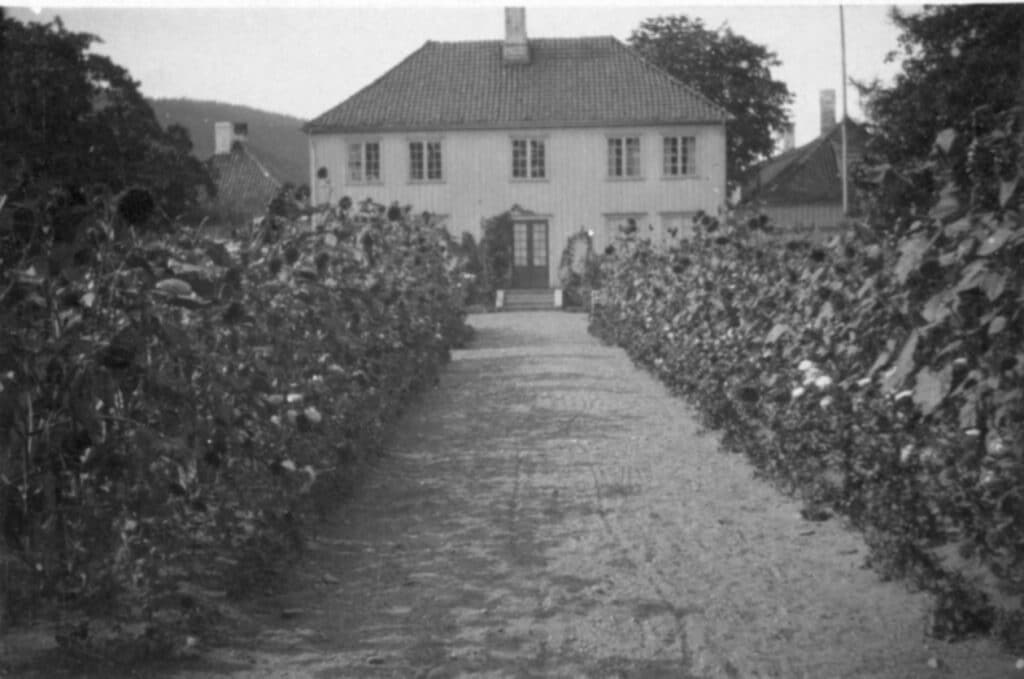
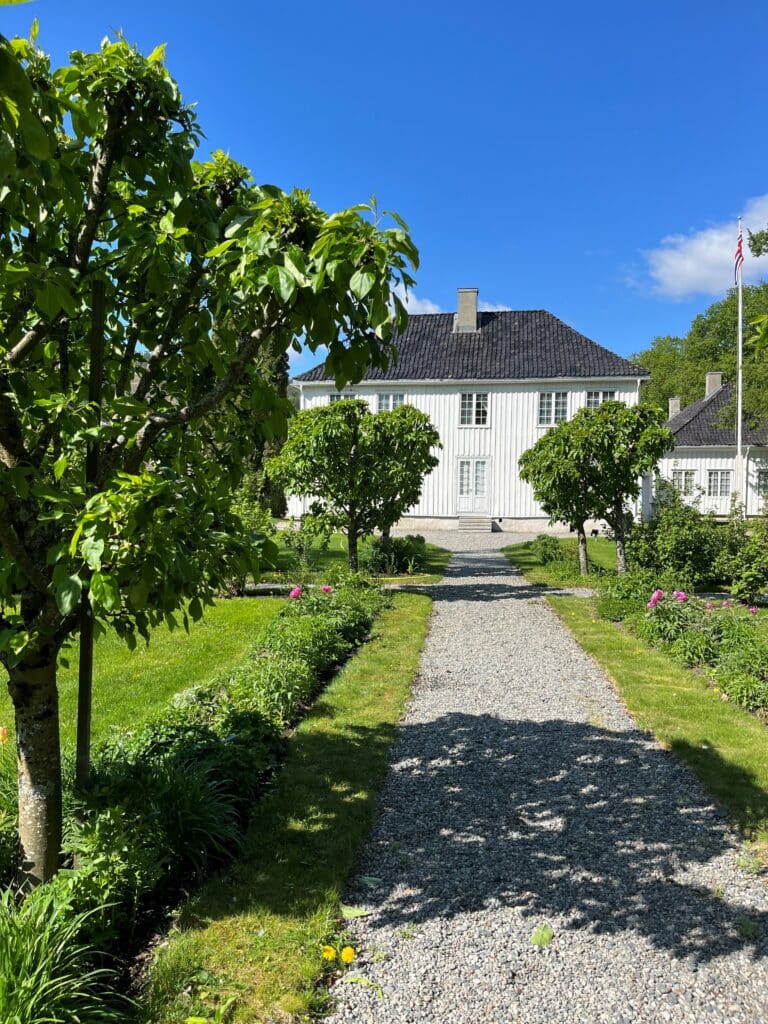
Marienlyst appears as a complete pleasure farm from the 1770s. And what exactly is an amusement park?
Initially, these facilities were built on agricultural properties or so-called loop properties. They were located some distance from the city centers, but not further away that one could travel into the city if business called.
Here wealthy townspeople could retire and hopefully take a few moments of freedom from material sorrows. Then the distinction between the public and the private became fundamental: How did one appear in public and what was one like behind the facade in one's free time? The farms were mainly used in the summer, but several eventually became year-round residences, which was also the case for Marienlyst at the beginning of the 19th century. Names of well-known pleasure farms in the Drammen area, however, emphasize their use in the summer season: Frydenhaug, Sommerfryd and not least Marienlyst.
Already the ancient Romans distinguished between one villa urbana, which was inside the city, and a villa suburbana which was away from the hustle and bustle of the city. Here they could combine the useful with the pleasant (delectare a prodesse), i.e. both agriculture and sociability. So here we can actually draw the line from Italian antiquity all the way to Drammen's pleasure grounds.
The combination of matauk and country life at a reasonable distance from the city's hustle and bustle was few and far between. One also had the option of leaving a city center in case of plague and cholera. This clearly emphasizes the difference between the social strata.
In a pleasure garden complex, buildings and gardens are usually closely linked, as in the more distinguished manor estates and castles we find in Norway. A good example of the latter is the newly restored park that surrounds the pleasure castle Oscarshall on Bygdøy. This was certainly laid out as a romantic garden with winding paths. The historic garden between the East wing and the gazebo on Marienlyst, on the other hand, has a tight axial feel. It was reworked in 2006-2008 after thorough investigations of previous structures of gravel paths and planting. It was largely the same garden history expertise that contributed here as during the work on the park at Oscarshall.
They painted the wall hangings in the great living room – East Wing Marienlyst
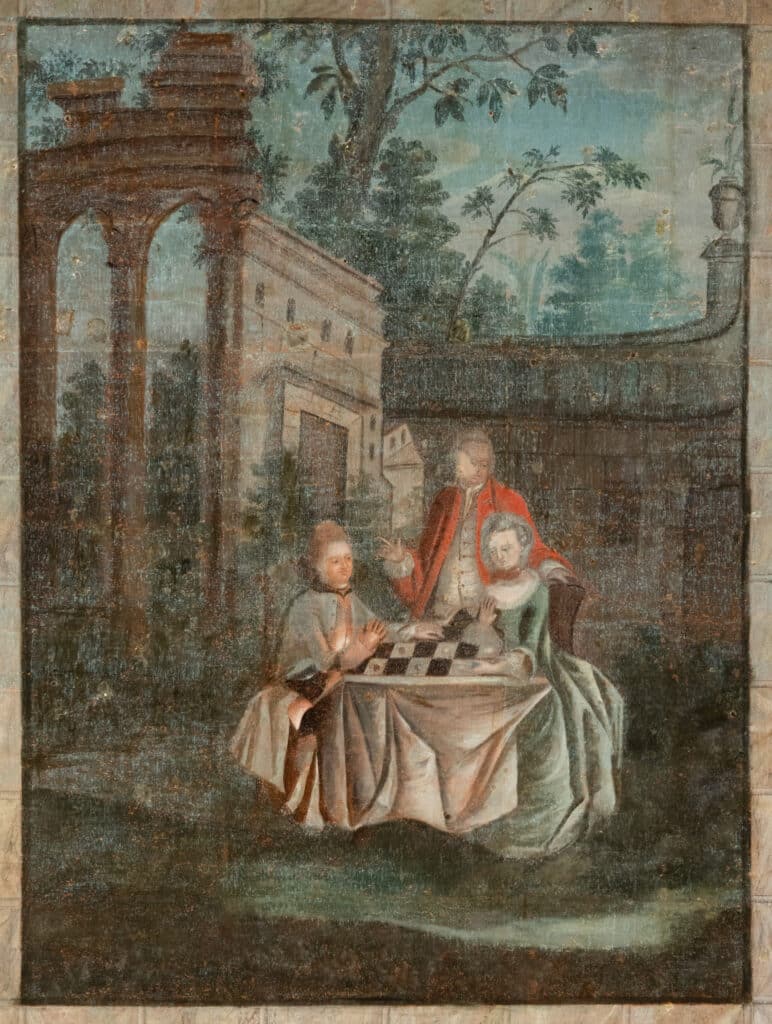

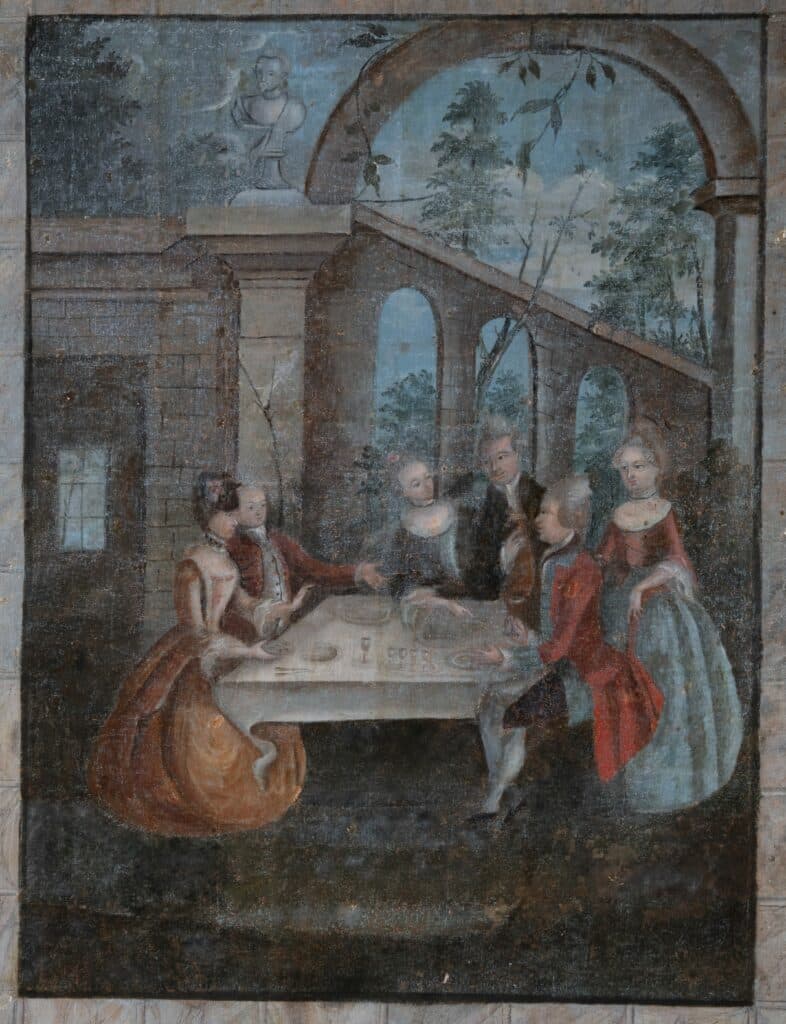

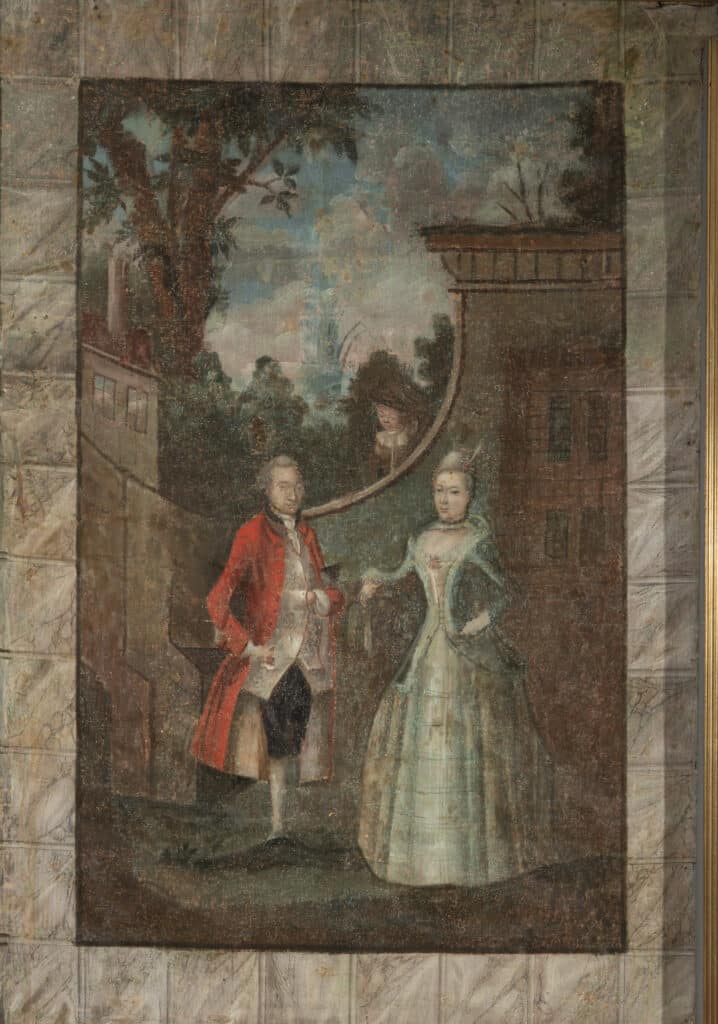
Let yourself be inspired by the painted wallpapers in the great living room in the so-called East Wing at Marienlyst. The room is perhaps the most exciting in the entire amusement park facility, quite simply a small art historical treasure chest. The tapestries, which date from the late 1770s, were rediscovered in 1951 in connection with restoration work. Under a total of 9 layers of paper wallpaper and two layers of paint, decorative pictorial fields were found which were probably painted by Johan Diderich von Dram (1725-1798).
The fields are set over a marbled chest panel and show a stately life out in the green. Here we see, among other things, elegant ladies engaged in board games and a well-dressed gentleman playing the flute while his graceful companion flips through sheet music. Distinguished people sit around a set table, and in two of the scenes we also witness what is probably a successful and less successful courtship. The scenes are rendered with overgrown, ancient ruins in the background which act as a kind of backdrop.
In one of the fields, a festive married couple poses. This may be a double portrait of harbor bailiff and war councilor Hans Thomas Weyer (1728-1790) and his wife Magdalena (c. 1732 – 1815) welcoming their guests. It was Weyer who built Marienlyst as we know it today, with a two-storey main building and lower side wings. The facility was completed around 1780 and got its name Weyersfryd according to the owner. Here the family could retire and indulge in rural activities a good distance away from the apartment building they owned on Strømsø. As befits an amusement park facility, a park with a small gazebo was also built.
Marienlyst has had several owners throughout history, and it was when grocer Hans Malling (1748-1816) and his wife Marie (1751-1820) took over that the facility got its name Marienlyst which is today the name of the entire area.
Read about the Marienlyst project in media here.
See also...
Opening of Perspektiv Drammen - Artwork from the museum's collections
Perspective Drammen
Artwork from the museum's collections
22.02.24-04.08.24
Opening of the November exhibition 2023
22.11. opened Buskerud Visual artists and Drammens Museum November exhibition 2023. We welcome you to a great exhibition in the Lychepaviljon from 23.11.23 to 07.01.24
The November exhibition 2023
The November exhibition 2023 opens on Wednesday 22 November at 18:00
The attacks on civilians must stop
We strongly condemn the killings of Israeli and Palestinian civilians taking place in the Middle East.

